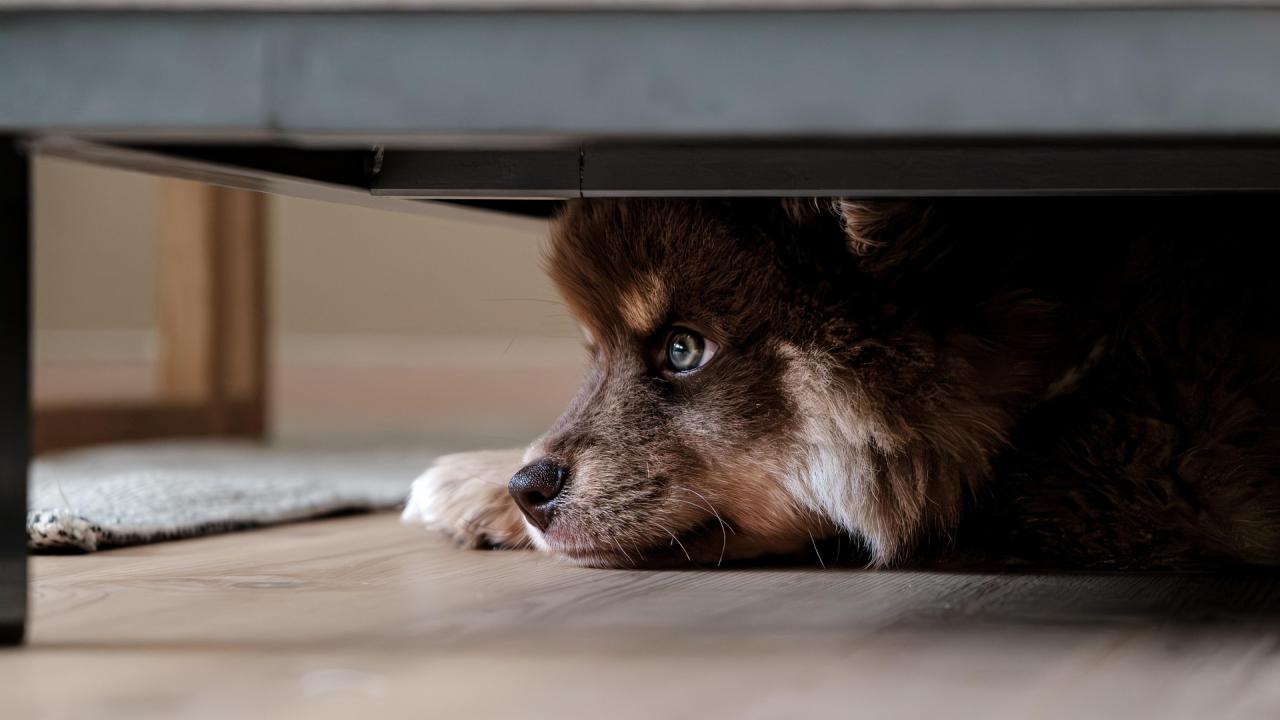
Fear of Fireworks
How we can help
Call 530-752-1393 to schedule an appointment with the Behavior Service.
Fear of Fireworks
Fear of loud noises is very common in pets. Fourth of July fireworks pose an exceptionally fearful stimulus for most dogs. Every year, dogs become so fearful that they may escape their yard or house and run the risk of becoming lost or hit by a car. Dogs do not develop these fears overnight, however, and there are techniques that can be used in the months before the stimuli to reduce this fear.
The first step is to identify exactly what is making your dog fearful. Make sure it is the sound of the fireworks, and not the sight or smell of gunpowder which is causing the fear. Each separate stimulus will require additional training.
It is important to demonstrate leadership to your pet. We want your dog to look to you for leadership and basic training commands. Basic training is essential for any dog in order to provide a safe and secure environment. Make sure your dog can “sit”, “come” and “stay” before any additional training is attempted.
To begin preparing for the Fourth of July holiday or any other situation in which you know your dog will be fearful, you must start training months ahead of time. The technique that we recommend is called “Counter conditioning and Desensitization.” Basically, your dog is currently conditioned to display excessive fearful response to a given stimulus. Our plan is to undo this learned behavior and replace it with a more relaxed behavior. This is called Counter-conditioning. We also want to expose the animal to the stimulus in a gradual and controlled manner which does not elicit the fearful behavior. This is called Desensitization.
In order to desensitize your dog to the sound of fireworks, you should invest in a sound effects CD of fireworks and some very tasty treats, cut into small pieces, as rewards. You should hold these training sessions multiple times per day, but for very short periods of time.
Begin by playing the CD at a very low volume, so that you can barely hear it. Make sure that the dog is not fearful of this level and then give the dog a few treats. Turn up the volume little bit and give the dog some more treats. If the dog shows any signs of fear do not punish the dog, but do not reward the fearful behavior with extra attention or reassuring words either. Some signs of fear include: ears back, dilated pupils, tail tucked, taking treats in a more forceful manner, or stopping taking treats altogether, salivating, panting, trembling . Always end on a good note, with the dog relaxed and readily taking treats. The goal is to counter condition the animal so that instead of displaying fearful, anxious and possibly destructive behaviors, it performs a favorable behavior, such as lying quietly in bed or going into its crate. This process does not happen quickly. This is the reason why we recommend beginning these training sessions weeks to months before the holiday. Patience is the key to any training session.
If the sight of fireworks also provokes a fearful response, you should repeat the technique above with a visual stimulus as well. You can use a video recording of the fireworks display or purchase some small fireworks, such as sparklers, with which to practice in your yard.
For safety during the event, he or she should be supervised during the event. A safe place to hide should be provided, such as a quiet bedroom, a crate inside the house, or a dog bed. In addition, closing the windows and blinds, and playing the radio or television may help to block out some of the stimuli.
In some circumstances, the training alone may not be enough to keep your dog safe for the holiday. Perhaps you did not have time to complete your training sessions or your dog has displayed such fearful behavior in the past that it has led to serious injury. In these instances, we would recommend that you schedule an appointment with your veterinarian to evaluate the possibility of prescribing some anti-anxiety medications to administer before the holiday. In addition, there are some pheromone products which may help alleviate some stress. These are available in a spray or diffuser formulation.
If these basic techniques are utilized, we hope to help prevent and alleviate the unnecessary fear and stress associated with loud noises.
If you have further questions, please contact your veterinarian.
*This article may not be reproduced without the written consent of the UC Davis School of Veterinary Medicine.
